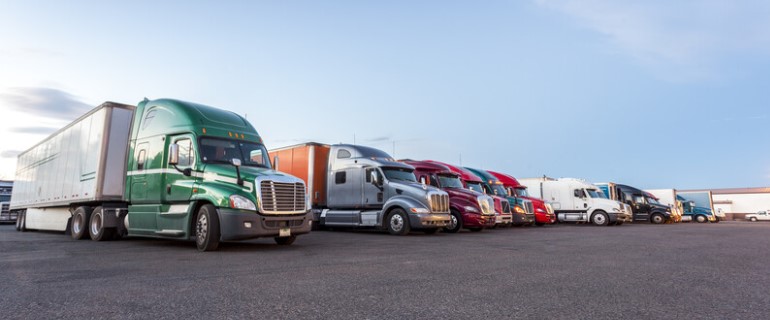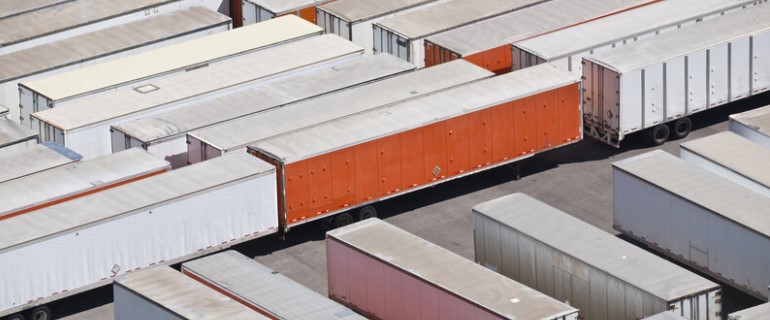Industrial outdoor storage, or IOS, a new property type born of climbing costs for traditional industrial buildings, is rapidly becoming a darling of the more opportunistic investors in commercial real estate, with an estimated market value of $200B in the U.S.
There’s no hard-and-fast definition for what makes an IOS property, but this nebulous property type benefits from two major factors: its simplicity and its physical constraints. Its simplicity makes it easy to manage. Its physical constraints, further restricted by unfriendly zoning laws, give it an element of urgency: Either get on board now or miss the train.
Just as there’s no official name for the property type — it can be called industrial outdoor storage, industrial storage facilities or an industrial prop parking facility, for example — there’s no agreed-upon understanding of just how big this market is, or even what property types this market comprises. The same term can include truck yards, maintenance shops, storage lots for shipping containers, equipment rental and even empty lots near ports.
No matter what you call them, these properties are widely understood by investors to be an appreciating asset intimately tied to logistics and industrial sites, and one that doesn’t have much room to grow outward: Few cities and municipalities want to zone for and encourage additional truck yards.
So despite all the cloudiness, there’s clarity around the potential in buying up property with continued demand and little to no risk of significant added supply. This competition for assets could lead to a frenzy and rapidly appreciating prices, making it harder for users that need the spaces to pay rising rents.
As industrial rents rise in many markets, tenants continue to ask themselves if they can’t simply store containers or vehicles outside, Grossman said. Vacancy in IOS fell below 3% in 2022, per a Marcus & Millichap report, while rents have spiked 30% since the end of 2019, compared to 24% for industrial rents.
There may not have been a singular event that kicked off what has become a gold rush for IOS in recent months, but the industrial and logistics situation during the pandemic underscored the value of these somewhat liminal spaces. IOS’ ties to traditional industrial sites may also be a limiting factor; as the sector cools, so might demand for these assets.
There had been an intensified drive to store trailer trucks, containers and equipment, beyond longtime uses by shipping and construction. Then the need to store and supply during an intense build-up of industrial demand, as well as a push to acquire and build more last-mile delivery spaces and consolidate logistics operations as fuel prices rose, created a condition for white-hot rent growth in IOS.
Now, these spaces are seen as an inflation hedge, and deep-pocketed investors have been making significant moves to acquire larger and larger portfolios.
IOS spaces typically exist next to port, rail, airports or intermodal transport spots. This makes the map of valuable real estate more diverse: Los Angeles and Charleston, South Carolina, both with port access, as well as Indianapolis and Oklahoma City, with truck terminals and a central U.S. location, offer great assets and opportunities. Asking rents may be south of $9 per SF, but rents rose more than 12% in 2022, with forecasts suggesting the surge will continue.
They’re defined as low coverage, meaning less than 20% of the space is covered with a building, like a garage or storage space. Infill opportunities abound; Grossman leased a gated parking lot to an Amazon facility near his office in Tulsa for “more than what a building might cost,” all so the retail giant could store its vans.
Industrial Outdoor Ventures CEO Tom Barbera, who started as an industrial broker in 1993 and formed his current venture in 2016, said the fundamentals of the space have always been strong. Despite many of the tenants being national, publicly traded companies with great balance sheets, it has traditionally been overlooked because it’s not what Barbera calls a “brochure-quality industrial real estate.”
In 2021, Industrial Outdoor Ventures sold a $200M portfolio to Stockbridge. Since then, the Chicago-based firm has acquired a 78-asset portfolio worth $1B, and has plans to start expanding into the Southeast in the next year or so.
Several funds have focused on IOS specifically, partnering with large investment banks as a JV partner. Big names in the space, according to Commercial Property Executive, include J.P. Morgan Global Alternatives and Zenith IOS, which formed a $700M joint venture last February; Alterra Property Group, which closed its Alterra IOS Venture II LP with $524M in investments; and Criterion Group and Columbia Pacific Advisors, whose joint venture plans to deploy $2B by the end of the year.
With average deal size between $5M and $15M for a property, Barbera said, many of the larger investors may lack specific IOS strategies. They tend to rely on others to assemble portfolios for them to acquire, typically by buying out existing mom-and-pop owners. That’s one reason it has become such a regionalized, fragmented submarket. Expertise in the space, since it’s very niche, is often hard to come by, so lots of brokers and buyers come from retail and self-storage, which may be oversaturated, looking for the next big thing.
An industrial slowdown could begin to cool down the sector. But Pontius doesn’t see a chance of a true slowdown for IOS; even if demand for industrial significantly cools after the skyrocketing market of the last 12 to 24 months, the already increased supply of warehouses and shipping routes might actually make IOS even more sought-after as a means of handling increased logistics traffic. Worst-case scenario, investors can redevelop this space into more traditional industrial uses and find another high-performing valuable use, which in turn further restricts the supply of IOS.
Source: Bisnow




